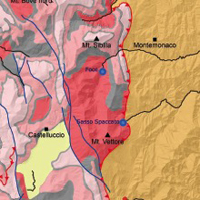Preliminary results on the response of some springs of the Sibillini Mountains area to the 2016-2017 seismic sequence

All claims expressed in this article are solely those of the authors and do not necessarily represent those of their affiliated organizations, or those of the publisher, the editors and the reviewers. Any product that may be evaluated in this article or claim that may be made by its manufacturer is not guaranteed or endorsed by the publisher.
Authors
The dynamic of groundwater systems feeding several springs of the Sibillini Mountains was deeply affected by nine Mw 5.0÷6.5 seismic events occurred in central Italy starting from August 2016. The strongest shock occurred on October 30th 2016 about 5 km NNE of Norcia Town, 9 km below the surface, as a result of upper crust normal faulting on the nearly 30 km-long Mt Vettore - Mt Bove fault system, a NW-SE trending, SW-dipping fault system outcropping on the western slope of Mt Vettore, the highest peak of Sibillini Mountains. Soon after this event, a general increase of springs and rivers discharge and groundwater levels was observed both in the Visso and Norcia areas, west of the Sibillini Mountains. In the Visso area the hydrogeological changes due to the seismic sequence exhausted in the 2019, while nowadays both discharges and groundwater levels are still higher than before in the Norcia area. Discharge data of the main springs located east, south-east of the Sibillini Mountains were analysed to verify whether the general increase observed on the western side was associated to a decrease on the eastern and southern-east area. The results show that the springs located on the eastern side and southern-east side of Mt Vettore experienced a significant long-term discharge decrease. In this preliminary work, the analysis of the historical discharge series of the Pescara di Arquata spring (SE of Mt Vettore), and its relationship with the Standard Precipitation Index (SPI) shows that the very low discharge values recorded during the post-seismic period are not associated with SPI as low as documented in the past for similar discharges. Moreover, the stable isotopic composition of Pescara di Arquata water during the post-earthquake period is slightly different from that measured before the seismic events; this suggests that a lower amount of water having more enriched isotopic δ18O content reaches the spring after the seismic sequence. These aspects seem to indicate that groundwater circulation in the southern-east area of Sibillini Mountains has been affected by the 2016-2017 seismic sequence.
Supporting Agencies
C.I.I.P. Servizio idrico Integrato, Regione Marche - Servizio Protezione Civile, Centro Funzionale MultirischiHow to Cite
PAGEPress has chosen to apply the Creative Commons Attribution NonCommercial 4.0 International License (CC BY-NC 4.0) to all manuscripts to be published.














